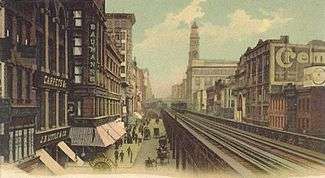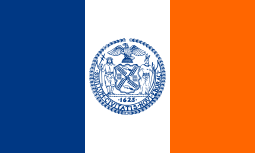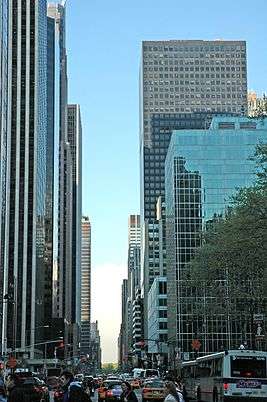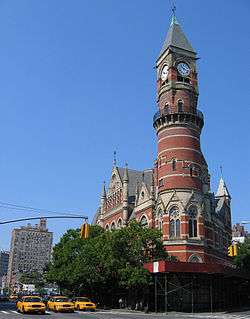Sixth Avenue (Manhattan)
|
The "skyscraper alley" of International Style buildings along Sixth Avenue looking north from 40th Street to Central Park | |
| Other name(s) | Avenue of the Americas |
|---|---|
| Owner | City of New York |
| Maintained by | NYCDOT |
| Length | 3.7 mi[1] (6.0 km) |
| Location | Manhattan, New York City |
| South end | Church / Franklin Streets in Tribeca |
| Major junctions | Herald Square in Midtown |
| North end | Central Park South / Center Drive in Midtown |
| East | Fifth Avenue (north of Waverly Pl) |
| West |
Varick Street (south of Houston St) Seventh Avenue (north of Houston St) |
| Construction | |
| Commissioned | March 1811 |
Sixth Avenue – officially Avenue of the Americas, although this name is seldom used by New Yorkers[2][3][4] – is a major thoroughfare in New York City's borough of Manhattan, on which traffic runs northbound, or "uptown". It is commercial for much of its length.
Sixth Avenue begins four blocks below Canal Street, at Franklin Street in TriBeCa, where the northbound Church Street divides into Sixth Avenue to the left and the local continuation of Church Street to the right, which then ends at Canal Street. From this beginning, Sixth Avenue traverses SoHo and Greenwich Village, roughly divides Chelsea from the Flatiron District and NoMad, passes through the Garment District and skirts the edge of the Theater District while passing through Midtown Manhattan.
Sixth Avenue's northern end is at Central Park South, adjacent to the Artists Gate traffic entrance to Central Park at Center Drive. Historically, Sixth Avenue continued north of Central Park, but that segment was renamed Lenox Avenue in 1887 and co-named Malcolm X Boulevard in 1987.[5]
History


Sixth Avenue was laid out in the Commissioners' Plan of 1811. As originally designed, Sixth Avenue's southern terminus was at Carmine Street in Greenwich Village. In the early and mid 1800s it passed by the popular roadhouse and tavern Old Grapevine at the corner of 11th street, which in the early 1800s was the northern edge of the city.[6] The IRT Sixth Avenue Line elevated railway (the "El") was constructed on Sixth Avenue in 1878, darkening the street and reducing its real-estate value.
Proposals to extend the street south from Carmine Street, to allow easier access to lower Manhattan, were discussed by the city's Board of Aldermen as early as the mid-1860s.[7] The southern extension was carried out in the mid-1920s, to ease traffic in the Holland Tunnel, facilitate construction of the IND Eighth Avenue Line and to connect with Church Street near its northern end, forming a continuous four-lane through-route for traffic from Lower Manhattan. Construction of the extension resulted in considerable dislocation to existing residents. One historian said that "ten thousand people were displaced, most of them Italian immigrants who knew no other home in America".[8] According to the WPA Guide to New York City, the extension resulted in blank side walls facing the "uninspiring thoroughfare" and small leftover spaces.[9] Dozens of buildings, including the original Church of Our Lady of Pompeii, were demolished.
In late 1887, the Harlem portion of what was then considered Sixth Avenue was renamed Lenox Avenue[10] for philanthropist James Lenox; it was later co-named Malcolm X Boulevard, in honor of the slain civil rights leader, a century later.[11][12]
By the mid-20th century, a coalition of commercial establishments and building owners along Sixth Avenue campaigned to have the El removed. The El was closed on December 4, 1938 and came down in stages, beginning in Greenwich Village in 1938–39; the Sixth Avenue subway replaced it a couple of years later.[9]
Demolition of the Sixth Avenue elevated railway, meanwhile, resulted in accelerated commercial development of the avenue in Midtown. Beginning in the 1960s, the avenue was entirely rebuilt above 42nd Street as an all-but-uninterrupted avenue of corporate headquarters housed in glass slab towers of International Modernist style. Among the buildings constructed was the CBS Building at 52nd Street, by Eero Saarinen (1965), dubbed "Black Rock" from its dark granite piers that run from base to crown without a break; this designated landmark is Saarinen's only skyscraper.
On March 10, 1957, Sixth Avenue was reconfigured to carry one-way traffic north of its intersection with Broadway in Herald Square.[13] The rest of the avenue followed on November 10, 1963.[14]
In the mid-1970s, the city "spruced up" the street, including the addition of patterned brick crosswalks, repainting of streetlamps, and new pedestrian plazas. Special lighting, rare throughout the rest of the city, was also installed.[15]

Renaming and co-naming
The avenue's official name was changed to Avenue of the Americas in 1945 by the City Council, at the behest of Mayor Fiorello La Guardia,[16] who signed the bill into law on October 2, 1945.[17] The intent was to honor "Pan-American ideals and principles"[18] and the nations of Central and South America, and to encourage those countries to build consulates along the avenue.[19] It was felt at the time that the name would provide greater grandeur to a shabby street,[20] and to promote trade with the Western Hemisphere.[21]
After the name change, round signs were attached to streetlights on the avenue, showing the national seals of the nations honored. However, New Yorkers seldom used the avenue's newer name,[4] and the street has been labelled as both "Avenue of the Americas" and "Sixth Avenue" in recent years. Most of the old round signs with country emblems were gone by the late 1990s, and the ones remaining were showing signs of age.[21]
Notable buildings and events
Sights along Sixth Avenue include Juan Pablo Duarte Square;[22] with the polychrome High Victorian Gothic Jefferson Market Courthouse, currently occupied by the Jefferson Market Library;[23] the surviving stretch of grand department stores of 1880 to 1900 in the Ladies' Mile Historic District that runs from 18th Street to 23rd Street;[24] the former wholesale flower district; Herald Square at 34th Street,[25] site of Macy's department store;[26] Bryant Park from 40th to 42nd Streets;[27] and the corporate stretch above 42nd Street, which includes the Bank of America Tower, W. R. Grace Building, International Center of Photography, Rockefeller Center — including the Time-Life Building, News Corp. Building, Exxon Building and McGraw-Hill Building, as well as Radio City Music Hall. The Steinway Hall of New York was moved to 1130 Sixth Avenue in October 2014.[28] A new Steinway Hall is planned to open on 1155 Sixth Avenue in 2015.[29]
Sixth Avenue is the site of the annual Village Halloween Parade in Greenwich Village[30] and the Dominican Day Parade in Midtown.
Mass transit
Sixth Avenue is served by the New York City Subway with the IND Sixth Avenue Line (B D F M trains) north of Houston Street, and the IND Eighth Avenue Line (A C E trains) south of Greenwich Avenue. The Harlem portion of Sixth Avenue (Lenox Avenue) is served by the IRT Lenox Avenue Line (2 3 trains) north of Central Park North. The PATH to New Jersey also runs under Sixth Avenue (JSQ–33 HOB-33 trains) from 9th to 33rd Streets.
In popular culture
The avenue is referenced both in the name and in the lyrics of "6th Avenue Heartache" by The Wallflowers.[31]
See also
 New York City portal
New York City portal- 6½ Avenue
References
- ↑ Google (September 13, 2015). "Sixth Avenue" (Map). Google Maps. Google. Retrieved September 13, 2015.
- ↑ Moscow, Henry (1978), The Street Book: An Encyclopedia of Manhattan's Street Names and Their Origins, New York: Hagstrom, ISBN 0823212750, p.24
- ↑ Finnegan, Jack (2007). Newcomer's Handbook For Moving to and Living in New York City. First Books. p. 43.
Avenue of the Americas, a name rarely used by New Yorkers
- 1 2 Cudahy, Brian J. (1995). Under the Sidewalks of New York. Fordham University Press. p. 132.
New Yorkers stubbornly resist calling Sixth Avenue by the name it has officially borne since the La Guardia years
- ↑ "What's in a Street Rename? Disorder", The New York Times, July 20, 1987. p. B1
- ↑ "Village Landmarks - The Old Grapevine Tavern". NYPL. Retrieved 7 February 2014.
- ↑ "Street Improvements". The New York Times. August 12, 1877. Retrieved June 20, 2010.
- ↑ Gold, Joyce. From Trout Stream to Bohemia: A Walking Guide to Greenwich Village History (1988:49)
- 1 2 WPA Guide to New York City (1939) 1984:138
- ↑ "Honoring the Lenox Family", The New York Times, October 5, 1887, page 4
- ↑ Gray, Christopher. "Streetscapes/200-218 Malcolm X Boulevard, From 120th to 121st Street; A Once-Noble Row of Houses Hopes for Renewal", The New York Times, June 15, 2003. Accessed May 25, 2007.
- ↑ Malcolm X Boulevard, New York City Department of City Planning. Accessed May 25, 2007.
- ↑ Ingraham, Joseph (March 11, 1957). "Midtown Gets New Traffic Pattern". The New York Times. Retrieved August 28, 2012.
- ↑ Stengren, Bernard (November 13, 1963). "One-Way Traffic Plan Tangled At 3 Broadway 'X' Intersections". The New York Times. Retrieved August 28, 2012.
- ↑ "Forgotten Street Scenes: Secrets of Sixth Avenue". Forgotten NY. Retrieved February 18, 2011.
- ↑ "Name of 6th Ave. to Be Changed To the Avenue of the Americas; Council Votes Proposal at Mayor's Request, 12 to 1, After a Debate Rages for 2 Hours --Isaacs Fears Oblivion for Historic Sites", The New York Times, September 21, 1945. p. 23
- ↑ "Sixth Avenue's Name Gone With the Wind; Sure Sign of Sixth Avenue's Passing" New York Times (October 3, 1945)
- ↑ "Avenue of the Americas" on the Lower Manhattan Cultural Council website
- ↑ "The other name for Sixth Avenue" on Ephemeral New York (January 3, 2010)
- ↑ Barry, Dan (September 21, 2005). "About New York; No Way To Name An Avenue". The New York Times. Retrieved June 20, 2010.
- 1 2 Gonzalez, David (July 4, 2008). "Few Emblems of Americas Remain on Their Avenue". The New York Times. Retrieved June 20, 2010.
- ↑ "Duarte Square". New York City Department of Parks & Recreation. Retrieved November 19, 2011.
- ↑
- ↑ "Ladies' Mile District Wins Landmark Status", New York Times (May 7, 1989)
- ↑ Herald Square - NYC Parks
- ↑ "Store Count and Square Footage – Macy's, Inc.". Macy's, Inc. Retrieved January 1, 2014.
- ↑ Bryant Park Corporation
- ↑ "Steinway Piano Showroom is Moving to a New Home in Midtown". The New York Times. 2014-10-30. Retrieved 2014-11-03.
- ↑ "Steinway Hall: Center of the Piano Universe". Steinway & Sons. Retrieved February 1, 2015.
- ↑ "Village Halloween Parade". halloween-nyc.com. Retrieved August 29, 2015.
- ↑ "Sixth Avenue Heartache by The Wallflowers Songfacts". songfacts.com. Retrieved August 29, 2015.
External links
| Wikimedia Commons has media related to 6th Avenue (Manhattan). |
- New York Songlines: Sixth Avenue – a virtual walking tour

